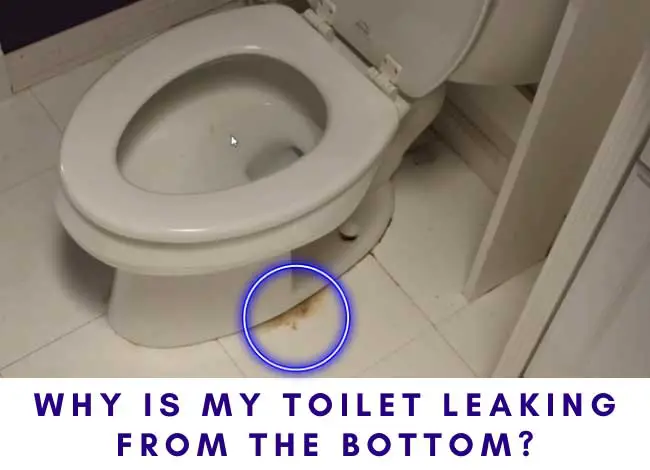
If you have ever walked into your bathroom and noticed a puddle of water forming around the toilet, your first thought is usually: “Why is my toilet leaking from the bottom?” This question is more common than you might think, and the answer isn’t always straightforward. Toilets are designed to create a watertight seal where the base meets the floor, but when something goes wrong, even a small issue can allow water to escape.
At its core, a toilet relies on three main components to prevent leaks at the bottom:
- The wax ring or gasket that seals the toilet to the drain flange.
- The closet bolts that secure the toilet firmly to the floor.
- The toilet bowl and tank structure itself, which must remain intact without cracks.
If any of these fail, water from each flush can seep out and pool on your bathroom floor.
The tricky part is that water at the base of your toilet doesn’t always mean the toilet itself is leaking. Sometimes, the moisture comes from condensation on the tank, a loose water supply line, or even a hidden crack in the porcelain. Because of this, homeowners often mistake harmless issues for serious leaks—or worse, ignore the warning signs until the problem escalates.
The real danger of a leaking toilet bottom is not the water you can see—it’s the damage you can’t. Even a small amount of water can seep beneath flooring materials, soaking into the subfloor. Over time, this leads to rotting wood, warped vinyl or tile, and even mold growth. In severe cases, the entire bathroom floor may need replacement.
That’s why asking “Why is my toilet leaking from the bottom?” is so important. Identifying the root cause quickly can save you from expensive structural repairs and potential health hazards. In the following sections, we’ll look at the most common causes, how to diagnose them, and step-by-step solutions that can help you restore your toilet to proper working condition.
Common Causes of a Toilet Leaking from the Bottom
When homeowners ask, “Why is my toilet leaking from the bottom?”, the answer usually falls into a handful of common causes. Understanding these potential problems helps you narrow down the issue before making costly repairs. Let’s go through the most frequent culprits.
1. Worn-Out Wax Ring
The wax ring is a simple yet crucial component that sits between the toilet base and the drain flange. Its job is to create a watertight seal so that every flush sends waste directly into the sewer line without leaking.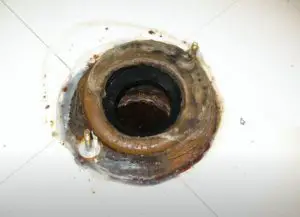
Over time, however, wax rings lose their shape. They can harden, crack, or shift slightly out of place due to regular use or movement of the toilet. Once that seal breaks, water escapes at the base during flushes.
🔹 Updated Note (2025): Many plumbers now recommend wax-free toilet seals made from rubber or foam. These modern alternatives are easier to install, last longer, and hold up better in areas with temperature fluctuations.
2. Cracked Toilet Bowl or Tank
Another common cause when asking, “Why is my toilet leaking from the bottom?” is a crack in the porcelain. Even tiny hairline cracks can allow water to seep through. These cracks may form in the bowl, leading to leaks directly onto the floor, or in the tank, causing water to drip down and pool at the base.
Cracks usually occur when a toilet experiences sudden impact (like dropping a heavy object on it) or if bolts were overtightened during installation.
3. Loose or Improperly Tightened Bolts
Your toilet is anchored to the floor with closet bolts. If these bolts loosen, the toilet begins to wobble slightly with each use. This movement weakens the wax seal, which then lets water escape.
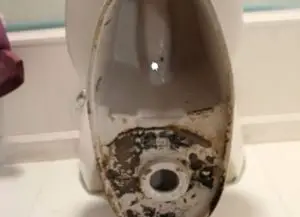
Sometimes, a newly installed toilet leaks at the base because the bolts were not tightened evenly. If one side is tighter than the other, the seal becomes uneven, leading to leaks.
4. Condensation (The “Phantom Leak”)
Not every wet floor is caused by a plumbing issue. In humid environments, condensation often forms on the cold porcelain surface of the toilet tank or bowl. This water then drips down and collects at the base, creating the illusion of a leak.
While condensation is harmless, it can still damage bathroom flooring if it happens frequently.
5. Loose or Faulty Water Supply Line
If the water supply line or fill valve connected to your toilet develops a leak, water can trickle down the back of the toilet and pool at the base. In this case, it might look like the toilet itself is leaking, when the real culprit is the supply connection.
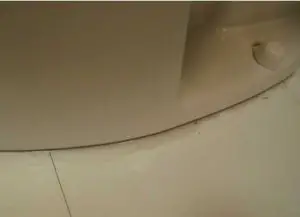
6. Clogged Drain Line
Sometimes the cause of water at the base isn’t the toilet at all but the drain line. A blockage in the drain can force water backward, putting pressure on the wax ring. This pressure eventually breaks the seal, causing water to seep out at the floor level.
This type of leak is usually accompanied by slow drainage or frequent clogs elsewhere in your plumbing system.
How to Diagnose Why Your Toilet Is Leaking from the Bottom
By now, you know the most common causes behind a toilet leak, but the real challenge is confirming which one applies to your bathroom. Many homeowners ask themselves, “Why is my toilet leaking from the bottom if I can’t see where the water is coming from?” That’s because leaks can be deceptive. Sometimes it’s the wax ring, sometimes the bolts, and sometimes just condensation. Diagnosing the issue carefully will save you time, money, and unnecessary repairs.
Related: How to Adjust the Water Level in the Toilet Bowl
Here’s a step-by-step guide to figuring out the source of your toilet leak:
Step 1: Dry the Area Completely
Before starting, use paper towels or an absorbent cloth to dry the floor around the base of the toilet. This creates a clear baseline so you can see exactly where new water appears.
Step 2: Perform a Flush Test
Flush the toilet and watch closely. If water begins seeping out at the base immediately after the flush, it strongly suggests a worn-out wax ring or loose bolts. If no water appears right away, move to the next checks.
Step 3: Inspect the Water Supply Line
Run your hand along the supply hose that connects the toilet to the shut-off valve. If it feels damp or you see small droplets forming, the supply line or its connection may be leaking. In this case, water can run down the back of the toilet and pool at the bottom, giving the impression of a base leak.
Step 4: Check for Tank and Bowl Cracks
Use a flashlight to carefully examine the bowl and tank. Look for hairline fractures, especially around the base of the bowl or near the tank bolts. Even small cracks can allow water to escape slowly.
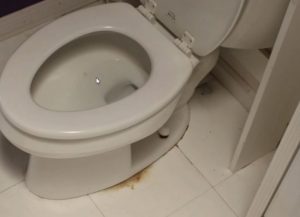
Step 5: Test for Toilet Rocking
Place your hands firmly on each side of the toilet and gently rock it back and forth. If you feel movement, the closet bolts are probably loose. A rocking toilet almost always breaks the seal of the wax ring, which explains why you’ll find water at the base after flushing.
Step 6: Rule Out Condensation
Touch the water you see on the floor. If it feels cool and you notice moisture forming on the tank or bowl in humid conditions, the culprit may be condensation, not a leak. This is sometimes called a “phantom leak,” because it mimics the signs of a real one.
Step 7: Watch for Signs of Drain Issues
If the toilet leaks intermittently—sometimes after flushing, sometimes not—it could point to a drain line clog. Other clues include slow flushing, gurgling sounds, or backups in nearby sinks and showers. In such cases, the problem goes beyond the toilet and involves your household plumbing system.
Related: How to Fix Common Toilet Problems
Step-by-Step Fixes for a Toilet Leaking at the Base
Once you’ve diagnosed the issue, the next step is taking action. Many homeowners panic when they discover water around their toilet, asking themselves, “Why is my toilet leaking from the bottom, and how do I fix it?” The good news is that most of these repairs can be done at home with basic tools. Below, you’ll find detailed solutions for each cause.
Fixing a Worn-Out Wax Ring
This is the most common repair. While it may sound intimidating, replacing a wax ring is a manageable DIY project that usually takes about two hours.
What you’ll need: Adjustable wrench, gloves, putty knife, sponge, bucket, and a new wax or wax-free seal.
Steps:
- Shut off the toilet’s water supply.
- Flush and sponge out any remaining water from the bowl and tank.
- Disconnect the water supply line.
- Remove the bolts securing the toilet and carefully lift it off the floor.
- Place the toilet on an old towel or cardboard.
- Scrape away the old wax from the flange using a putty knife.
- Position a new wax or wax-free seal on the flange.
- Reset the toilet, pressing down firmly to seat the seal.
- Reinstall and tighten the bolts evenly (don’t overtighten).
- Reconnect the supply line and test flush several times.
This simple replacement usually solves the problem completely.
Fixing a Cracked Toilet Bowl or Tank
If your diagnosis revealed a crack, unfortunately, repairs are limited. Small surface cracks can sometimes be patched with waterproof epoxy, but deep cracks typically require replacement.
- Cracked bowl: Replace the entire bowl to avoid ongoing leaks and sanitation risks.
- Cracked tank: Replacing the tank alone may be possible, but in most cases, buying a new toilet is more cost-effective and safer.
Tightening Loose Bolts
If your toilet wobbles, the bolts need attention.
Steps:
- Remove the plastic caps over the bolts.
- Using a wrench, tighten each bolt a little at a time, alternating sides.
- Stop once the toilet feels secure.
⚠️ Warning: Never overtighten, as this can crack the porcelain base.
Addressing Condensation
If you concluded that moisture was due to condensation rather than a leak, you don’t need major repairs.
Solutions:
- Run a bathroom exhaust fan during showers to reduce humidity.
- Install an anti-sweat mixing valve that warms the cold water entering the tank.
- Use a toilet tank insulation kit to reduce surface temperature differences.
Related article: How to Remove Toilet Rings Forever
Replacing a Faulty Water Supply Line
If the supply line or fill valve is leaking, replacement is quick and inexpensive.
Steps:
- Shut off the water supply.
- Unscrew the old supply line at both ends.
- Replace it with a braided stainless-steel line, which is more durable.
- Reconnect tightly, turn the water back on, and check for drips.
Clearing a Clogged Drain Line
If you discovered that a clogged drain line is putting pressure on the wax seal, the fix requires clearing the blockage.
Steps:
- Use a plunger first to see if the clog dislodges.
- If not, insert a plumber’s auger (toilet snake) into the drain to break up the obstruction.
- For severe or recurring clogs, hire a professional plumber to inspect the system.
Preventing Future Toilet Leaks
After spending time and effort fixing your bathroom, the last thing you want is to ask again, “Why is my toilet leaking from the bottom?” Prevention is the key to saving yourself from repeated repairs, water damage, and costly renovations. Luckily, with a few smart habits and upgrades, you can keep your toilet in top condition for years to come.
1. Inspect Regularly
Every few months, take a moment to check around the toilet base. Look for moisture, soft flooring, or even a faint musty smell. These early warning signs allow you to catch small leaks before they cause major structural damage.
2. Replace Wax Rings on Schedule
Wax rings generally last between 5 to 10 years, but heavy household use or frequent toilet movement can shorten their lifespan. If you’re already replacing a toilet or renovating the bathroom, it’s smart to install a new seal while the toilet is lifted. For long-term reliability, consider a wax-free rubber or foam seal.
3. Use Toilet Shims for Stability
A rocking toilet is one of the fastest ways to ruin a wax ring. If your toilet wobbles slightly, insert small plastic shims at the base to stabilize it. Once leveled, caulk around the base to keep it secure and prevent leaks.
4. Handle Bolts with Care
Improper tightening of closet bolts is one of the hidden reasons people later ask, “Why is my toilet leaking from the bottom?” Tighten bolts evenly and gently—never overtighten, as that can crack the porcelain or distort the wax seal.
5. Upgrade the Supply Line
Traditional plastic or rubber supply hoses wear out faster. Upgrading to a braided stainless-steel line dramatically reduces the chance of future leaks, since these lines are more durable and resistant to pressure changes.
6. Control Bathroom Humidity
If condensation has ever tricked you into thinking your toilet was leaking, it’s worth addressing humidity. Use an exhaust fan during showers, run a small dehumidifier in poorly ventilated bathrooms, or insulate the toilet tank with a kit to reduce sweating.
7. Schedule Professional Check-Ups
Even if everything seems fine, a plumber can inspect your toilet and drain lines during routine maintenance visits. A quick inspection every couple of years helps ensure no hidden leaks are developing beneath your bathroom floor.
Frequently Asked Questions
1. Why is my toilet leaking from the bottom when I flush?
The most likely culprit is a worn-out wax ring. Each time you flush, water escapes past the broken seal and pools around the base. Replacing the wax ring usually solves this issue.
2. Can a cracked toilet bowl or tank really cause leaks at the base?
Yes. Even small, invisible cracks can allow water to seep out continuously. If the crack is in the bowl, replacement is necessary. If it’s in the tank, sometimes epoxy can help, but often replacement is the safer option.
3. Why does my toilet leak sometimes but not all the time?
Intermittent leaks usually indicate that the wax ring is only partially damaged or that the closet bolts are loose. When the toilet shifts slightly during use, water sneaks past the weakened seal.
4. How do I know if condensation is the real problem?
If the water feels cool and forms droplets on the outside of the tank or bowl, especially in humid weather, it’s condensation. This is harmless but can still damage flooring over time if not controlled.
5. Can a loose water supply line make it seem like the toilet is leaking?
Absolutely. A worn or loose supply line drips down the back of the toilet, eventually pooling at the base. Replacing it with a braided steel line is a quick and long-lasting fix.
6. How much does it cost to fix a toilet leaking from the bottom?
DIY fixes like wax ring replacement cost under $20 in parts. If you call a professional plumber, expect to pay anywhere between $100 and $200, depending on your location and the complexity of the repair.
Final Thoughts
Discovering water on your bathroom floor is frustrating, but now you know the answer to the question: “Why is my toilet leaking from the bottom?” Whether it’s a deteriorated wax ring, a cracked toilet bowl, loose bolts, or just condensation, the cause can be identified with careful inspection.
The key takeaway is this: don’t ignore a leak. Even small amounts of water can seep into your flooring and subfloor, causing rot, mold, and expensive repairs. Acting quickly with the right fix—whether tightening bolts, replacing a wax ring, or upgrading your supply line—will save you both money and stress.
So, the next time you notice a puddle near your toilet, you won’t have to panic or guess. You’ll know exactly how to ask the right question—“Why is my toilet leaking from the bottom?”—and you’ll have the knowledge to take swift, effective action.
Hi, this is Robert Crossan, the owner of this website, has 17 years of experience in the installation, maintenance, and repair of toilets and plumbing systems. After completing the Level 2 Basic Plumbing course in 2005, I started working in both domestic and commercial buildings as a professional plumber. So I can figure out the core difference between different toilet models and brands. It also helped me monitor their work performance and setbacks.

Good morning! Thank you for your advice and instructions. I’m 62 years old and I’m going to give this a try and let you know how it turns out.